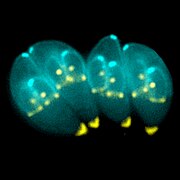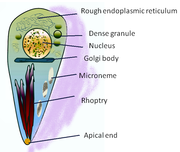Type: Protozoa
Name: Toxoplasma gondii
Importance- to Body:
Parasitic Infection
Distribution- in Body:
Tissue cysts can form in virtually any organ predominantly forming and persistent in the brain, the eyes, and striated muscle (including the heart)
Epidemiology:
Food Sources:
Raw Meat, Undercooked Meat; Especially: Lamb, Pork, Venison, Unwashed Vegetables
Environmental/Geographic Sources:
Cutting Boards,Garden Soil, Sandbox, Litter Box, Cats, Warm-blooded Animals, Anything that has come into contact with cat faeces
Diagonosis:
Serological Dye Test, patient history, symptoms, laboratory test results, including an antibody titer test and microscopic examination of tissues
Treatment:
No human vaccine is currently available, but is being constantly researched.
For Acute Symptoms: Pyrimethamine, Sulfadiazine, Clindamycin, Spiramycin, Minocycline
For Latent Symptoms: Atovaquone, Clindamycin
During Pregnancy:DSpiramycin or pyrimethamine/sulfadiazine and Folinic acid may be used for treatment
Supplemental information:
Toxovax is an approved live vaccine for sheep and considered to provide lifetime protection.
Largely associated with cats, T. gondii can infect any warm blooded animal.
Many studies indicate evidence T. gondii may alter behavior in a host in turn allowing it to spread and reproduce.
| Toxoplasma gondii | |
|---|---|

| |
| Giemsa stained T. gondii tachyzoites, 1000× magnification | |
| Scientific classification | |
| Domain: | Eukaryota |
| (unranked): | SAR |
| (unranked): | Alveolata |
| Phylum: | Apicomplexa |
| Class: | Conoidasida |
| Order: | Eucoccidiorida |
| Family: | Sarcocystidae |
| Subfamily: | Toxoplasmatinae |
| Genus: | Toxoplasma Nicolle & Manceaux, 1909
|
| Binomial name | |
| Toxoplasma gondii (Nicolle & Manceaux, 1908) Nicolle & Manceaux, 1909
| |
Toxoplasma gondii (/ˈtɒksoʊplæzmə
In humans, T. gondii is one of the most common parasites in developed countries;serological studies estimate that 30–50% of the global population has been exposed to and may be chronically infected with T. gondii, although infection rates differ significantly from country to country. For example, previous estimates have shown the highest prevalence of persons infected to be in France, at 84%. Although mild, flu-like symptoms occasionally occur during the first few weeks following exposure, infection with T. gondii produces no readily observable symptoms in healthy human adults. This asymptomatic state of infection is referred to as a latent infection and has recently been associated with numerous subtle adverse or pathological behavioral alterations in humans. In infants, HIV/AIDS patients, and others with weakened immunity, infection may cause a serious and occasionally fatal illness, toxoplasmosis.
T. gondii has been shown to alter the behavior of infected rodents in ways that increase the rodents' chances of being preyed upon by felids. Support for this "manipulation hypothesis" stems from studies showing T. gondii-infected rats have a decreased aversion to cat urine. Because cats are the only hosts within which T. gondii can sexually reproduce to complete and begin its lifecycle, such behavioral manipulations are thought to be evolutionary adaptations that increase the parasite's reproductive success. The rats would not shy away from areas where cats live and would also be less able to escape should a cat try to prey on them. The primary mechanisms of T. gondii–induced behavioral changes in rodents is now known to occur through epigenetic remodeling in neurons which govern the associated behaviors; for example, it modifies epigenetic methylation to cause hypomethylation of arginine vasopressin-related genes in the medial amygdala to greatly decrease predator aversion. Widespread histone-lysine acetylation in cortical astrocytes appears to be another epigenetic mechanism employed by T. gondii. Differences in aversion to cat urine are observed between non-infected and infected humans and sex differences within these groups were apparent, too.
A number of studies have suggested that subtle behavioral or personality changes may occur in infected humans, and infection with the parasite has recently been associated with a number of neurological disorders, particularly schizophrenia and bipolar disorder. A 2015 study also found cognitive deficits in adults to be associated with joint infection by both T. gondii and Helicobacter pylori in a regression model with controls for race-ethnicity and educational attainment. Although a causal relationship between latent toxoplasmosis with these neurological phenomena has not yet been established, preliminary evidence suggests that T. gondii infection may induce some of the same alterations in the human brain as those observed in mice.



